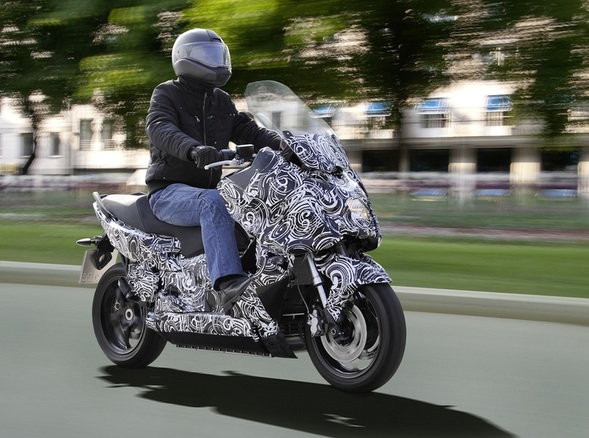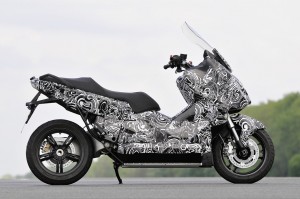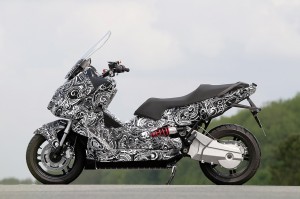BMW Motorrad Concept Vehicle BMW E-Scooter. Innovative development study with electric drive.
Space is becoming increasingly scarce in the major conurbation centres and traffic density is growing continuously. Political and social conditions are changing. All these factors coalesce in increasing demands in terms of private transportation. The concept vehicle BMW E-Scooter with electric drive provides an innovative look at changing urban mobility needs.
While the currently available, purely electrically-powered scooters have been almost exclusively used inside towns and cities to date due to their perform- ance and range, which makes them suitable for short distances only, the concept vehicle BMW E-Scooter offers a much broader spectrum of use.
High range and excellent performance figures.
Since it was conceived as a future-oriented vehicle for commuting between urban areas and the city centre, therefore attracting funding from the German Federal Ministry of Transport, Building and Urban Development, there were two main requirements for its development: dynamic figures comparable to those of a maxi scooter with a combustion engine and a high range in realistic conditions of use.
The concept vehicle BMW E-Scooter provides the necessary sustained output and maximum speed for safe and reliable overtaking on urban motorways and also when carrying two people. It is also easily capable of managing hill starts on steep slopes with a pillion passenger.
The development study also has the necessary maximum output to be able to achieve acceleration figures within the important 0 – 60 km/h range, which are at the level of current maxi scooters powered by a 600 cc combustion engine.
The high storage capacity of the battery allows a daily driving range of over 100 kilometres. In this way, the BMW E-Scooter concept vehicle provides a long-term, zero-emissions urban and suburban travel option which is suitable for everyday use.
Fast charging at conventional power sockets.
The E-Scooter concept vehicle’s battery is charged at regular household power sockets as found in Europe, the USA, Canada and Japan, so no special charging station is required. When the battery is completely flat, the charging period is less than three hours. However, practical experience has shown that the battery rarely runs out completely, so charging times are generally shorter.
Frame.
Unlike existing maxi scooters with combustion engines, the concept vehicle does not have a main frame. Instead, the aluminium battery casing — which also contains the electronic system required for battery cell monitoring — takes over the function of the frame. The steering head support is connected to it, as is the rear frame and the left-hand mounted single swing arm with directly hinged, horizontally installed shock absorber.
Electric machine, power electronics and charging device.
Due to its high output, the BMW Motorrad development study has no hub motor with direct drive or planetary gearbox. Instead, the high-performance electric machine is mounted behind the battery casing. The secondary drive consists of a toothed belt from the electric machine to the belt pulley mounted coaxially on the swinging fork pivot with drive pinion. From here, power transmission occurs via roller chain to the rear wheel. When the E-Scooter is decelerated in trailing throttle or when braking, the energy re- leased is recuperated, thereby increasing the vehicle’s range by between 10 and 20 per cent depending on driving profile.
The electrical components required for the electric drive are installed on the top of the battery casing. The external battery electronics system perma- nently collects and monitors data such as the temperature and voltage of the battery cells, both during travel and while charging. The power electronics acts as a control system and controls the electric machine. The charging device includes a charge cable which allows the battery to be recharged at a conventional household power socket. In addition to the other components like an ISO insulation monitor, high-voltage indicator and a high-voltage distributor, a DC-DC converter is included. It is required to change high voltage to low voltage power to supply the 12 volt vehicle supply and especially for the control units.
Cooling system.
During travel, the electric machine and power electronics are liquid-cooled, as is the charging device during charging. An electric coolant pump ensures coolant circulation through the radiator. While a coolant is commonly used for the battery in electrically powered cars, the E-Scooter concept vehicle uses an air cooling system in order to save space.
Safety.
BMW Motorrad is one of the very few motorcycle manufacturers to be able to draw on its own experience and expertise in the automobile field in the development of electrically powered vehicles. Synergies are derived from the development of the BMW E-Scooter concept vehicle not just in the ready availability of technical components but also in the area of high voltage engineering and the associated safety requirements. Here for the first time, standards established by the leading automobile manufacturers relating to high voltage safety (> 60 volt) and functional reliability are being applied to a two-wheel vehicle with electric drive. (Source: BMW Group)
Watch the videos below to see the BMW E-Scooter in action.
Also see related posts:
No Comment… BMW’s Scooter Concept C Video





